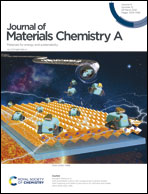Core–shell-structured CNT@hydrous RuO2 as a H2/CO2 fuel cell cathode catalyst to promote CO2 methanation and generate electricity†
Abstract
H2/CO2 fuel cells are important devices that convert CO2 into CH4 while generating electricity at mild temperatures. Anhydrous ruthenium oxide (RuO2) on carbon nanotubes (CNT) as a cathode catalyst causes CO2 methanation, but the methane production rate needs to be improved. In this paper, a core–shell structure of CNT@hydrous RuO2 was fabricated by a simple sol–gel method. Unlike anhydrous RuO2, which is a single electronic conductor, CNT@hydrous RuO2 is a proton–electron mixed conductive material. Therefore, protons transfer not only in thepolybenzimidazole (PBI) film but also in the catalyst layer with the assistance of crystalline water in hydrous RuO2. CO2 methanation involving a reaction of multiple protons and electrons can be accelerated. The methane generation rate of CNT@hydrous RuO2 reached 331.2 μmol gcat−1 h−1 at 190 °C which is 3 times higher than that of anhydrous RuO2. This research result provides an effective strategy for the catalytic reaction of multiple proton–electron transfers.



 Please wait while we load your content...
Please wait while we load your content...